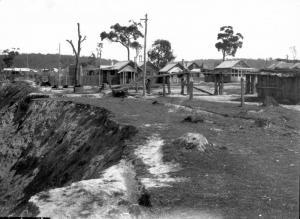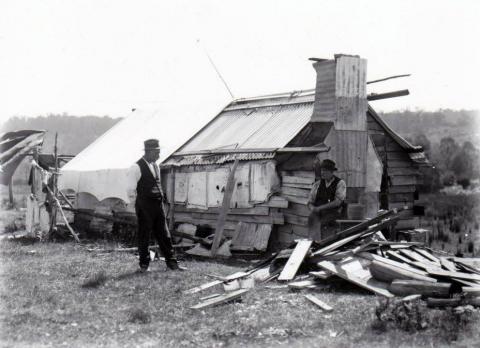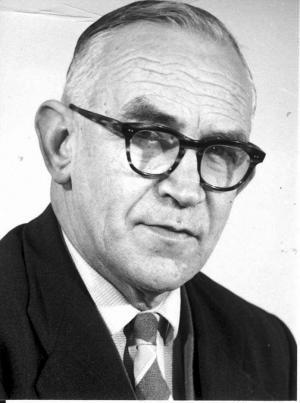1928 - A CRISIS AT THE BROWN COAL MINE SETTLEMENT
Life was difficult for many families in and around Yallourn in earlier times as can be seen from the following newspaper article.
The story was published in ‘The Argus’ in 1928; and told of a series of deaths caused by an outbreak of gastro-enteritis at the Brown Coal Mine settlement.
The epidemic at the Brown Coal Mine settlement gained widespread coverage throughout the nation; and one newspaper (‘Advocate’-Burnie, Tasmania) attracted great attention when it printed that the deaths at the BCM had been caused by meningitis.
The extract described the actions taken by the medical authorities during the emergency; and several paragraphs highlighted the responsibilities of Yallourn’s Dr James Moore Andrew during the harrowing time in local history.
The description of the workers’ homes at the Brown Coal Mine, as outlined by Dr Harris in his report to the Health Commission, gives readers an insight into the unforgiving living conditions of the workers of that era.
Another brief news item (positioned below the main article) carried the headline: ‘Another Child Taken to Hospital’. The article implied that the epidemic had not run its full course; and that the anxieties, of residents at the Brown Coal Mine, had not been quelled.
March 7th 1928 ‘THE ARGUS’ Page : 27
YALLOURN EPIDEMIC.
FOOD CONTAMINATION
HEALTH COMMISSION REPORTS.
"Houses Unfit for Habitation."
At the end of last month an epidemic, believed at the time to be meningitis occurred at the Brown Coal Mine settlement, near the State Electricity Commission’s works at Yallourn and seven died.
Following the epidemic the Health Commission requested the district health Officer at Sale (Dr. H.E. Harris) and the medical officer of health at Yallourn (Dr. J.M. Andrew) to furnish reports regarding the outbreaks. These were received yesterday at a meeting of the Health Commission.
The cause of the epidemic has now been established as gastro-enteritis not meningitis. Dr Harris described the conditions under which some the State Electricity Commission’s employees live with their families at the Brown Coal Mine Settlement.
In his report Dr Andrew said:-
‘On February 9 there occurred the first case of a serious epidemic of acute gastro-enteritis among the young children and infants at the Brown Coal Mine. Since then there have been 15 cases. It is very unfortunate that on February 28th, this outbreak was erroneously reported as an epidemic of meningitis.
There has been no meningitis among the cases in this area. The cause of the epidemic was, in my opinion, the moist steamy weather, the large number of flies prevalent this summer, improper means of preventing contamination of food, and especially of milk in the homes by flies and the failure of parents to realise the necessity of reporting the cases for treatment immediately the symptoms occurred. There is every evidence that the epidemic is now practically at an end, as no fresh cases have been reported in the last six days.’
Dr Harris reported as follows:-
I visited Yallourn on March 1 to investigate the reported serious epidemic of meningitis there. The Brown Coal township is built on high ground to the north of the Latrobe River. The town has never been laid out in any order, people just building their homes where it happened to suit them best.
The place is thus a confused jumble of dwellings with tracks and streets running between them. The dwellings are a very mixed type, some being bark huts, others being made of wood slabs and palings. Those of more recent origin are constructed of weatherboards, and a few of fibro-cement sheets.
In addition the old types of homes have been enlarged as necessity arose, with rooms of galvanised iron or even petrol tins. Approximately 40 per cent to 50 per cent of the dwellings in this area are not fit for human habitation. Many of the houses have only two or three rooms and some only one. Dr Andrew pointed out to me the house in which the cases had developed, and they were all of the type described.
The assistant general superintendent of the State Electricity Commission (Mr Dixon) informed me that the work was gradually being stopped at this mine and he expected that within 12 months there would be a much smaller population residing there. Dr Andrew also informed me that every year there is an outbreak of gastro-enteritis at this township. It has been milder in the last two years but this year the outbreak was very sudden and the infection apparently of a very virulent kind.
I am of the opinion that the causes of the outbreak were those mentioned by Dr Andrew in his report. The main contributing factor was, however, the extremely unsanitary conditions at the township. I intend to make a detailed sanitary survey of this area.
The chairman (Dr. Robertson) remarked that, although the Health Commission had power to compel a municipal council to condemn houses considered unfit for human habitation it might find it difficult to apply such regulations to buildings at the Brown Coal Mine ( which is in the Shire of Narracan) because the whole district was practically controlled by the Electricity Commission.
The commission decided that before discussing the matter fully it would await a further report from Dr Harris.
Another Child Taken to Hospital
Another case of gastro-enteritis has occurred at Yallourn. The victim, a child aged I8 months, lived in the settlement near the old brown coal field. The patient has been removed to hospital.
FOOTNOTES
1. The news of the seven deaths at the Brown Coal Mine settlement sent a wave of fear throughout Australian mining communities. The story was published in West Australia (e.g. ‘Great Southern Herald’), Queensland (‘Brisbane Courier’), Tasmania (‘The Mercury’) and also in NSW (‘The Sydney Morning Herald’). Miners in distant locations would have been extremely interested in the events at the Brown Coal Mine.
2. The reports regarding the calamity varied from place to pace. For example, a Rockhampton newspaper (‘The Morning Bulletin’: May 2nd 1928) stated that nine children had died…
“Following the epidemic of gastro-enteritis, which occurred at the State Electricity Commission's brown coal mine, Yallourn, in February, as the result of which nine children died, a report has been received by the commission, attributing the cause of the outbreak to the extremely unsanitary conditions prevailing in the township. Investigations revealed a shocking state of affairs. Many houses were described as unfit for habitation and recommended to be condemned. Alterations were advocated to other buildings. The matter will he considered by the health commission.” Page: 9
3. The widespread reporting of the epidemic would have placed further pressure on the Victorian health authorities and an incredible strain on Yallourn’s only Medical Officer Dr Andrew.
4. Dr James Moore Andrew (born:1899) had arrived in Yallourn in 1926. He was chosen for the position of Resident Medical Officer of Yallourn from 19 other candidates.
5. Dr Andrew took over the medical duties and responsibilities of Dr Hugh Mitchell (who resided at Morwell). Dr Mitchell was the first doctor at the mining camps in those early days of settlement. An article regarding Dr. Mitchell’s remarkable work as the M.O in the Yallourn camps is also posted on this website.
6. As is well known by former residents of Yallourn, Dr Andrew was a physician noted for his boundless energy and genuine concern for the community. Dr Andrew was an heroic character in the story of Yallourn; and he would have approached the epidemic in ‘head-on’ fashion and with the utmost diligence.
7. It should be remembered that the calamity occurred more than 85 years ago; and the emergency would have severely tested Dr Andrew’s knowledge, resources and time. Further articles regarding Dr Andrew and his life in Yallourn can be found on this website… Type: ‘Dr Andrew’ in to the search field (top right hand corner of the screen and press: Enter.
8. The symptoms of gastro-enteritis include vomiting, diarrhoea, high temperatures (fever) and stomach pain; and it is not hard to imagine how difficult it would have been to treat such cases at home in 1928 (eg with small huts with large families, poor sanitation, lack of hot running water and effective disinfectants).
9. The hospitalisation of sick residents of the camps was a logistical challenge in terms of access to vehicles and distance. The Yallourn Hospital did not open until January 1929 and, up until that time, patients who required emergency treatment (eg the sick children as above) were conveyed to public hospitals at either Warragul or Sale Hospital. Note: It is known that a one-vehicle ambulance service began operations in Yallourn in October 1924.
10. Modern-day management of gastro-enteritis demands the provision of intravenous fluids to patients. In comparison, with the above story, the risk of death through dehydration and sepsis these days has been greatly reduced.
11. For further information regarding the life and times in the mining camps an excellent reference is Kath Ringin’s book: ‘The Old Brown Coal Mine.’
12. A recent illustrated book that deals with life in the camps in later years was written by Josef Sestokas in 2010 and is entitled ‘Welcome to Little Europe: Displaced Persons and the North Camp’…
“Between 1947 and 1951, Australia received over 170,000 displaced persons (DPs) from war-ravaged Europe. The author's father was aboard the first DP transport to arrive in Australia. From Bonegilla he was sent to work for the State Electricity Commission of Victoria (SECV) at Yallourn, along with 47 other Lithuanians, Latvians and Estonians. They lived in a hell-hole, the North Camp at Yallourn North, new Australians amongst hundreds of old Australians.” Source: Summary - National Library of Australia”
13. Readers may be interested to know that the Brown Coal Mine became known as Yallourn North in 1947 …
“The small settlement known for 60 years as Brown Coal Mine will be called Yallourn North as from August 1. The township is on the north side of the Latrobe River, about two miles from Yallourn. The open cut, near the town, which is supplying raw brown coal for industrial use, will be known as the Yallourn North open cut.” ‘The Argus’ July 25th 1947 Page: 4
____________________________________________________
The above story is part of an on-going project regarding the history of Yallourn. The story was researched and written by Roger Spaull and presented and posted by Julie George for the Virtual Yallourn website in August 2017.
The above article from ‘The Argus’ (Melbourne) has been faithfully reproduced. The only amendments to the original copy are the font style, font size and spacing, so as to enhance the article for purposes of posting on the Virtual Yallourn website.



